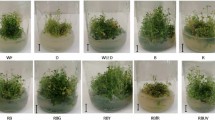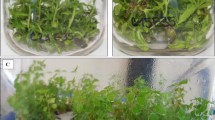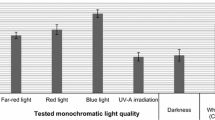Abstract
The present study was conducted with the aim of evaluating the effects, over 6 days, of different intensities of continuous light (20, 40, and 60 µmol photons m-2 s-1) on the growth of Arthrospira platensis and its impact on the production of phycocyanin, carotenoids, and intracellular/extracellular auxins, using a medium supplemented with 0.5 g L-1 of L-tryptophan. Additionally, the study aimed to assess the effect of treatments on the biostimulant activity of the supernatant (T0: untreated, T1: treated) compared to that of biomass extracts (T2). T0, T1, and T2 were adjusted to a concentration of 0.1 mg L-1 of indole-3-acetic acid (IAA) and a pH of 7.4. The results revealed that light intensities of 40 and 60 µmol photons m-2 s-1 produced the highest levels of extracellular IAA on day 2 (20.1 and 33.01 mg L-1, respectively), while an intensity of 20 µmol photons m-2 s-1 reached peak IAA production on day 3 (25.74 mg L-1), followed by a subsequent decrease. Phycocyanin concentrations markedly decreased after maximal IAA production under all light conditions. Tukey's analysis indicated that treatments T1 and T2 significantly increased the number and length of secondary roots in mung beans by 157% and 350%, respectively, with no significant differences between them, while the untreated supernatant (T0) exhibited a minor effect. The study concludes that under all assessed light conditions, concentrations of phycocyanin and carotenoids drastically decreased after peak IAA production, gradually recovering in the following days. Additionally, the treated supernatant and biomass extract significantly enhanced root growth in mung beans, highlighting the importance of the treatment method for biostimulation and suggesting potential for improved storage and transportation. Future research should focus on refining supernatant treatments to optimize biostimulant activity and facilitate commercialization.



Similar content being viewed by others
Data availability
The data supporting the findings of this study are available from the corresponding author upon reasonable request.
References
Ahmed M (2010) Production of indole-3-acetic acid by the cyanobacterium Arthrospira platensis strain MMG-9. J Microbiol Biotechnol 20:1259–65
Akgül F (2019) Effect of Spirulina platensis (Gomont) Geitler extract on seed germination of wheat and barley. Alienteri J Agr Sci 34:148–153
Ambrosini S, Prinsi B, Zamboni A, Espen L, Zanzoni S, Santi C, Varanini Z, Pandolfini T (2022) Chemical characterization of a collagen-derived protein hydrolysate and biostimulant activity assessment of its peptidic componentsm. J Agric Food Chem 70:11201–11211
Bennett A, Bogorad L (1973) Complementary chromatic adaptation in a filamentous blue-green alga. J Cell Biol 58:419–35
Chaiklahan R, Chirasuwan N, Bunnag B (2012) Stability of biomass extracted from Spirulina sp.: Influence of temperature, pH and preservatives. Process Biochem 47:659–664
Conselvan GB, Pizzeghello D, Francioso O, Di Foggia M, Nardi S, Carletti P (2017) Biostimulant activity of humic substances extracted from leonardites. Plant Soil 4:119–134
De Oliveira MA, Monteiro MP, Leite DG (1999) Growth and chemical composition of Spirulina maxima and Spirulina platensis biomass at different temperatures. Aquacult Int 7:261–275
Di Filippo-Herrera DA, Muñoz-Ochoa M, Hernández-Herrera RM, Hernández-Carmona G (2019) Biostimulant activity of individual and blended seaweed extracts on the germination and growth of the mung bean. J Appl Phycol 31:2025–203
Dos Santos RR, Corrêa PS, Dantas FML, Teixeira CMLL (2019) Evaluation of the co-production of total carotenoids, C-phycocyanin and polyhydroxyalkanoates by Arthrospira platensis. Bioresour Technol Rep 7:100226
Duong TT, Nguyen TTL, Van Dinh TH, Hoang TQ, Vu TN, Doan TO et al (2021) Auxin production of the filamentous cyanobacterial Planktothricoides strain isolated from a polluted river in Vietnam. Chemosphere 284:131242
European Union (2019) Regulation of the European parliament and of the council laying down rules on the making. Available on the market of EU fertilising products and amending regulations (EC) No 1069/2009 and (EC) No 1107/2009 and repealing regulation (EC) No 2003/2003. European Commission, Brussels, p 4. https://eur-lex.europa.eu/legal-content/EN/TXT/?uri=OJ:L:2019:170:TOC. Accessed 17 Aug 2023
Fernandes R, Campos J, Serra M, Fidalgo J, Almeida H, Casas A, Toubarro D, Barros AIR (2023) Exploring the benefits of phycocyanin: From Spirulina cultivation to its widespread applications. Pharmaceuticals 16:592
Geries LSM, Elsadany AY (2020) Maximizing growth and productivity of onion (Allium cepa L.) by Spirulina platensis extract and nitrogen-fixing endophyte Pseudomonas stutzeri. Arch Microbiol 203:169–181
Gifuni I, Pollio A, Safi C, Marzocchella A, Olivieri G (2019) Current bottlenecks and challenges of the microalgal biorefinery. Trends Biotechnol 37:242–252
Godlewska K, Michalak I, Pacyga P, Baśladyńska S, Chojnacka K (2019) Potential applications of cyanobacteria: Spirulina platensis filtrates and homogenates in agriculture. World J Microbiol Biotechnol 35:80
Hu Y, Li Y, Zhang Y, Li G, Chen Y (2011) Development of sample preparation method for auxin analysis in plants by vacuum microwave-assisted extraction combined with molecularly imprinted clean-up procedure. Anal Bioanal Chem 399:3367–74
Jafarlou MB, Pilehvar B, Modaresi M, Mohammadi M (2022) Interactive effects of seaweed and microalga extract priming as a biostimulant agent on the seed germination indices and primary growth of milkweed (Calotropis procera Ait.). Biologia 77:1283–1293
Kapoore RV, Wood EE, Llewellyn CA (2021) Algae biostimulants: A critical look at microalgal biostimulants for sustainable agricultural practices. Biotechnol Adv 49:107754
Lichtenthaler HK (1987) [34] Chlorophylls and carotenoids: Pigments of photosynthetic biomembranes. Meth Enzymol 148:350–382
Mógor ÁF, Ördög V, Lima GPP, Molnár Z, Mógor G (2018) Biostimulant properties of cyanobacterial hydrolysate related to polyamines. J Appl Phycol 30:453–460
Mohammed MK, Mohd MK (2011) Enhancement in production of phenolic compounds (AntiOxidants) in Spirulina plantensis under different IAA regimes. Int J Eng Sci Technol 3:3004–3009
Pagels F, Pereira RN, Vicente AA, Guedes AC (2021) Extraction of pigments from microalgae and cyanobacteria—A review on current methodologies. Appl Sci 11:5187
Pannacci E, Baratta S, Falcinelli B, Farneselli M, Tei F (2022) Mugwort (Artemisia vulgaris L) aqueous extract: hormesis and biostimulant activity for seed germination and seedling growth in vegetable crops. Agriculture 12:1329
Pichyangkura R, Chadchawan S (2015) Biostimulant activity of chitosan in horticulture. Sci Hortic 196:49–65
Salkowski E (1885) Ueber das Verhalten der Skatolcarbonsäure im Organismus. Z Physiol Chem 9:23–33
Savvas D, Ntatsi G (2015) Biostimulant activity of silicon in horticulture. Sci Hortic 196:66–81
Sharma SHS, Lyons G, McRoberts C, McCall D, Carmichael E, Andrews F, Swan R, McCormack R, Mellon R (2012) Biostimulant activity of brown seaweed species from Strangford Lough: Compositional analyses of polysaccharides and bioassay of extracts using mung bean (Vigno mungo L.) and pak choi (Brassica rapa chinensis L.). J Appl Phycol 24:1081–1091
Stramarkou M, Papadaki S, Kyriakopoulou K, Tzovenis I, Chronis M, Krokida M (2021) Comparative analysis of different drying techniques based on the qualitative characteristics of Spirulina platensis biomass. Aquat Food Prod Technol 30:498–516
Tanaka K, Kishi M, Assaye H, Toda T (2020) Low temperatures in dark period affect biomass productivity of a cyanobacterium Arthrospira platensis. Algal Res 52:102132
Varia J, Kamaleson C, Lerer L (2022) Biostimulation with phycocyanin-rich Spirulina extract in hydroponic vertical farming. Sci Hortic 299:111042
Villaró S, Acién G, Alarcón J, Ruiz Á, Rodríguez-Chikri L, Viviano E, Lafarga T (2023) A zero-waste approach for the production and use of Arthrospira platensis as a protein source in foods and as a plant biostimulant in agriculture. J Appl Phycol 35:2619–2630
Zapata D, Arroyave C, Cardona L, Aristizábal A, Poschenrieder C, Llugany M (2021) Phytohormone production and morphology of Spirulina platensis grown in dairy wastewaters. Algal Res 59:102469
Zarrouk C (1966) Contribution a l’étude d’une cyanophycée. Influence de divers facteurs physique et chimique sur la croissance et la photosynthèse de Spirulina maxima (Sech. et Gardner) Geitler. PhD Thesis, University of Paris, France
Zavřel T, Chmelík D, Sinetova MA, Červený J (2018) Spectrophotometric determination of phycobiliprotein content in cyanobacterium Synechocystis. J Vis Exp 11:58076
Funding
Financial support was provided by Colombian Ministry of Science and Technology (Grant 445-2021).
Author information
Authors and Affiliations
Contributions
Experimentation, analysis, writing, original draft development: NL. Review and supervision: HA. Methodology, conceptualization, review, and funding acquisition: HF.
Corresponding author
Ethics declarations
Competing interests
The authors declare no competing interests.
Additional information
Publisher's Note
Springer Nature remains neutral with regard to jurisdictional claims in published maps and institutional affiliations.
Rights and permissions
Springer Nature or its licensor (e.g. a society or other partner) holds exclusive rights to this article under a publishing agreement with the author(s) or other rightsholder(s); author self-archiving of the accepted manuscript version of this article is solely governed by the terms of such publishing agreement and applicable law.
About this article
Cite this article
López Mejía, N., Martínez Correa, H.A. & Lobatón García, H.F. Biostimulating activity of biomass extracts and supernatants from a culture of Arthrospira platensis enriched with L-tryptophan. J Appl Phycol (2024). https://doi.org/10.1007/s10811-024-03237-7
Received:
Revised:
Accepted:
Published:
DOI: https://doi.org/10.1007/s10811-024-03237-7




